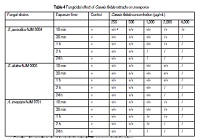In vitro antifungal activity of Cassia fistula L. against selected pathogenic water molds
Keywords:
Antifungal activity, Aquatic animals, Cassia fistula L., Water moldsAbstract
Water mold infections in both cultured and wild aquatic animals, caused by members of the genera Saprolegnia, Achlya, and Aphanomyces, have widely occurred worldwide. Outbreaks in aquatic creatures, especially in aquacultural facilities and fish hatcheries are common problem. Cassia fistula L. has been used as medicinal plant for broad purposes including for fungal infectious diseases remedy, but efficacy against water molds is still not apparently known. The present study was aimed to investigate in vitro antifungal activity of C. fistula stem-bark alcoholic extracts against the selected pathogenic water molds isolated from fish. The results showed that the C. fistula extract was capable to kill hyphae and zoospores of Saprolegnia paracitica NJM 8604 and S. diclina NJM 0005 at levels ranging from 1,000-4,000 microg/mL evidently within 24 h-exposure, while, a level of 500 microg/mL was sufficient to kill the both stages of Aphanomyces invadans NJM 9701. In addition, the antifungal activity of C. fistula absolute alcoholic extract comparing to 50% aqueous alcoholic extract were seemingly not different. Conclusively, the C. fistula stem-bark extracts, both absolute and 50% aqueous alcoholic extractions, were effectively able to inhibit growth and kill the 3 strains of pathogenic water molds by affect throughout the 2 important, zoospore and hyphal, stages.
References
Carballo M, Muñoz MJ. Effect of sublethal concentrations of four chemicals on susceptibility of juvenile rainbow trout (Oncorrhynchus mykiss) to Saprolegniasis. Appl Environ Microbiol 1991; 57: 1813-1816.
Hatai K, Hoshiai G. Saprolegniasis in cultured coho salmon. Fish Pathol 1992a; 27: 233-234.
Hatai K, Hoshiai G. Mass mortality in cultured coho salmon, Oncorhynchus kisutch, due to Saprolegnia parasitica Coker. J Wildl Dis 1992b; 28: 532-536.
Blaustein AR, DG Hokit, RK O'Hara, RA Holt. Pathogenic fungus contributes to amphibian losses in the Pacific-Northwest. Biol Cons 1994; 67: 251-254.
Kitancharoen N, Yuasa K, Hatai K. Morphological aspects of Saprolegnia diclina type I isolated from pejerrey, Odonthetes bonariensis. Mycoscience 1995; 36: 365-368.
Hussein MMA, Hatai K. Saprolegnia salmonis sp. nov. isolated from sockeye salmon, Oncorhynchus nerka. Mycoscience 1999; 40: 385-389.
Meyer FP, Jorgenson TA. Teratological and other effects of malachite green on the development of rainbow trout and rabbits. Trans Am Fish Soc 1983; 112: 818-824.
Srivastava RC. Fungal parasites of certain freshwater fishes of India. Aquaculture 1980; 21: 387-392.
Prabhuji SK, Srivastava GC, Rizvi SJH, Mathur SN. 1,3,7-Trimethylxanthine (caffeine); a new natural fish fungicide. Cell Mol Life Sci 1983; 39: 177-179.
Perrucci S, Cecchini S, Pretti C, Cognetti AMV, Macchioni G. In vitro antimycotic activity of some natural products against Saprolegnia ferax. Phytother Res 1995; 9: 147-149.
Kitanchroen N, Yamamoto A, Hatai K. Fungicidal effect of hydrogen peroxide on fungal infection of rainbow trout eggs. Mycoscience 1997a; 38: 375-378.
Kitanchroen N, Yamamoto A, Hatai, K. The fungistatic effect of NaCl on rainbow trout egg saprolegniasis. Fish Pathol 1997b; 32: 159-162.
Barnes ME, Ewing DE, Cordes RJ, Young GL. Observation on hydrogen peroxide control of Saprolegnia spp. during rainbow trout egg incubation. Prog Fish-Cult 1998; 60: 67-70.
Borisutpeth P, P Kanbutra, C Hanjavanit, K Chukanhom, D Funaki, K Hatai. Effects of Thai herbs on the control of fungal infection in Tilapia eggs and toxicity to the eggs. Aquaculture Sci 2009; 57(3): 475-482.
Borisutpeth P, P Kanbutra, C Hanjavanit, E Horiuchi, S Wada, K Hatai. The in vitro antifungal effects of chlorine dioxide on water molds. Aquaculture Sci 2010; 58(2): 219-224.
Rajan S, DS Baburaj, M Sethuraman, S Parimala. Stem and stem bark used medicinally by the Tribals Irulas and Paniyas of Nilgiri District, Tamil Nadu. J Nat Remedies 2001; 1(1): 49-54.
Prashanth KV, Chauhan NS, Padh H, Rajani M. Search for antibacterial antifungal agents from selected Indian medicinal plants. J Ethnopharmacol 2006; 107: 182-188.
Duraipandiyan V, Ignacimuthu S. Antibacterial and antifungal activity of Cassia fistula L.: An ethnomedicinal plant. J Ethnopharmacol 2007; 112: 590-594.
Hatai K, Egusa S. Studies on pathogenic fungus of mycotic granulomatosis III development of the medium for egg-fungus. Fish Pathol 1979; 13: 147-152.
Ali MA, Sayeed MA, Bhuiyan MSA, Sohel FI, Yeasmin MS. Antimicrobial screening of Cassia fistula and Mesua ferrea. J Med Sci 2004; 4(1): 24-29.
Hussein MMA, Wada S, Hatai K, Yamamoto A. Antimycotic activity of eugenol against selected water molds. J Aquat Anim Health 2000; 12: 224-229.
Mori T, Hirose H, Hanjavanit C, Hatai K. Antifungal activities of plant extracts against some aquatic fungi. Biocontrol Sci 2002; 7: 187-191.
Chukanhom K, Borisutpeth P, Hatai K. Antifungal activities of aroma components from Alpinia galanga against water molds. Biocontrol Sci 2005; 10: 105-109.
Willoughby LG, Pickering AD. Viable Saprolegniaceae spores on the epidermis of the salmonid fish Salmo trutta and Salvelnus alpinus. Trans Brit Mycol Soc 1977; 68: 91-95.



